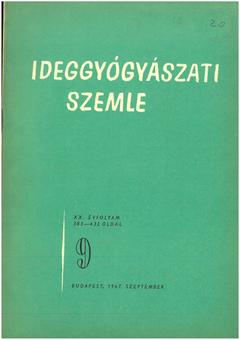The eLitMed.hu medical portal uses computer cookies for convenient operation. Detailed information can be found in the Cookie-policy.
Clinical Neuroscience - 1967;20(09)
Content
[Effect of anxiety on Achilles tendon reflex semi-relaxation time]
[In states of anxiety, the duration of the f. r. i. of the Achilles reflex decreases, although the decrease rarely reaches the extent of the decrease in f. r. i. induced by hyperthyroidism. Both placebo injections and exam situations cause a decrease in f.r.i., but the latter effect is several times greater than the former. In a patient in a state of anxiety, 10 mg. Frenolone i.m. 1 hour after the sedative effect, a significant increase in f.r. i. is observed. This effect is significantly greater than that observed in normal controls after administration of the same dose of the drug. In hyperthyroid patients, the f.r. i. of 10 mg. Frenolone hardly alters the effect. The different behaviour of normal controls and hyperthyroid subjects from anxious patients is presumably due to the fact that Frenolone only favourably affects the central arousal associated with anxiety. During psychopharmacon therapy of anxious neurotic and psychotic patients, a gradual elongation of f.r. i. is observed as the patients calm down. This provides an opportunity to objectively monitor the effect of the therapy. ]
[Valium (Diazepam) effects on epileptic crises and certain epileptic mechanisms]
[In addition to the generally observed good effect, we observed one case in which Valium worsened the epileptic mechanism (case 6). This observation seems to contradict the many reports in the literature that Valium has a good effect in petit mal and spike-wave mechanism. However, a distinction should be made between the different spike-wave mechanisms. In our other patient (case 3) we also observed a beneficial effect of Valium in spike-wave mechanism. However, this latter case was a spike-wave variant, slow spike-wave pattern. However, our case 6 showed a classic 3 c/s spike-wave pattern with clinical absances. It is not clear from the literature whether Valium is effective in all 3 c/s spike-wave mechanisms. Further experience in this direction is needed. Apart from the neuroleptic effect, no other "side effects" were observed. ]
[Data for the Autogen Training methodology and indicative questions]
[The authors outline the main factors involved in the development, practice and spread of AT. They briefly describe Schultz's classical method. They describe in more detail the methodology they developed, which they applied to groups of 6-10 patients and in which they attach great importance to suggestive support. They share their experience with AT treatment, which they find useful for AT indicatio: all personality types except H and I are suitable for learning the exercises. Of the psychic symptoms, mood disorders, feelings of insecurity, inner tension and anxiety in particular improved, and of the autonomic disorders, sweating, tremor, hypertension, enteral disturbances, insomnia and cephalgia responded most favourably. Based on their experience, they discuss the current and perspectivicus possibilities of AT in their department. In their opinion, a gradual diffusion of AT treatment can be expected due to its advantages over other psychotherapeutic methodologies and for the practical and theoretical reasons discussed. ]
[Persistent expansive-productive confabulatory image after contusio cerebri]
[The authors describe a 35-year-old male patient who developed a specific expansive confabulosis after contusio cerebri, which persisted and even progressed after the other symptoms of amnestic syndrome had resolved. The patient was re-examined 21 months after his first admission: the confabulosis persisted and was embedded in the symptoms of personality development suggestive of post-traumatic encephalopathy. The authors refer to their previous communication describing the medical history of four of their patients. Their new case analysis confirms their earlier findings and provides a catamnestic data set for this rare form of posttraumatic confabulosis. ]
[Diffuse demyelinating giant cell reticulomascoma metastases ]
[In a circumscribed case of metastatic reticulum sarcoma, severe oedema and demyelination were observed in both hemispheres. In the clinical picture, local symptoms attributable to the direct effect of the tumour were accompanied by bilateral hemisphaerial white matter lesions. In all cases of brain tumours, but especially in sarcoma metastases, bilateral symptoms should be considered not only bilateral tumour formation but also bilateral white matter oedema-necrosis.]
[On current problems in psychiatric methodology]
[Science is a systematically structured system. Today, the scientific status of psychiatry is threatened by the lack of a unified system for the many different views and schools of thought. The main reason for this critical situation is the lack of clarity of methodological problems. The methodological problem, taking into account its historical development, can be briefly outlined as follows. ]
[Sarcoma of the femoral nerve causing symptoms of "mononeuritis" ]
[A case of a 37-year-old female patient. A relatively small tumour, histologically consistent with a sarcoma, causing symptoms of femoral nerve dropout, was removed by complete transection of the nerve trunk. Surgery was performed 3 months after the first symptoms appeared. The patient has been symptom-free for 16 months so far. In our case, unilateral progressive lesions of the femoral nerve of unclear origin should be considered as tumours and surgical exploration should be considered in case of suspicion.]
1.
Clinical Neuroscience
[Headache registry in Szeged: Experiences regarding to migraine patients]2.
Clinical Neuroscience
[The new target population of stroke awareness campaign: Kindergarten students ]3.
Clinical Neuroscience
Is there any difference in mortality rates of atrial fibrillation detected before or after ischemic stroke?4.
Clinical Neuroscience
Factors influencing the level of stigma in Parkinson’s disease in western Turkey5.
Clinical Neuroscience
[The effects of demographic and clinical factors on the severity of poststroke aphasia]1.
2.
Clinical Oncology
[Pancreatic cancer: ESMO Clinical Practice Guideline for diagnosis, treatment and follow-up]3.
Clinical Oncology
[Pharmacovigilance landscape – Lessons from the past and opportunities for future]4.
5.



